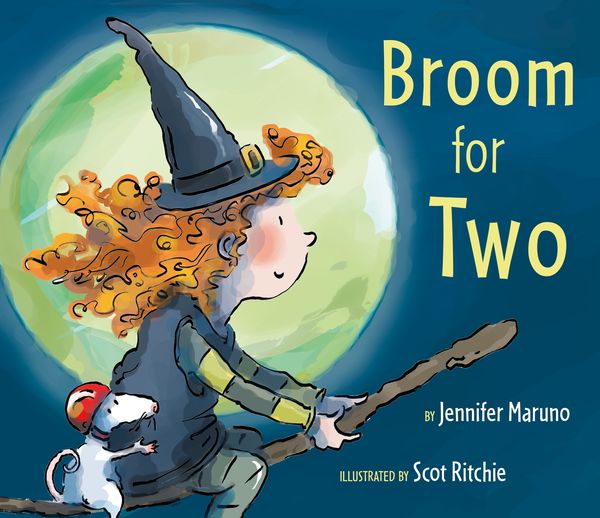Jennifer Maruno Sends a Young Witch and Her Rodent Sidekick on an Adventure in Broom for Two
Prolific children's author Jennifer Maruno may be familiar to readers of Open Book. In fact, as recently as last week, another title written by Maruno was featured on the site.
This time we're sharing a whimsical, uplifting tale about a young witch who keeps leaving her broom in odd places while practicing for her flying test. On the hunt to find it one particular day, Little Witch ends up in the woods at Ramshackle Rat's house, and her broom is chewed and damaged. Her flight home is an eventful and tricky one, with the broom misbehaving along the way.
Little Witch has no choice but to find a way to master the broom in time for her test, and, with an assist from a surprising ally, she strives to soar again. It's a fun and inspiring ride with wonderful illustrations from artist Scot Ritchie.
We've got some excellent insights into Broom for Two (Pajama Press) to share with our readers today. Check out this Kid's Club interview with the author!
Open Book:
Is there a message you hope kids might take away from reading your book?
Jennifer Maruno:
Broom for Two is about kindness and getting by with a little help from a friend. It’s not made explicit that Ramshackle Rat chews Little Witch’s broom, but when he is in trouble she reaches out to him. In turn, he balances out her flight. Isn’t that what friends do for us? They balance out our own flight through life.
OB:
Is there a character in your book that you relate to? If so, in what ways are you similar to your character and in what ways are you different?
JM:
Little Witch is careless with her most prized possession, her broom, and it becomes damaged. I once had a beautiful ballerina doll who became “sick with the measles.” The only problem was I used a ball point pen to give her the measles and it wouldn’t come off no matter how hard I tried. I kept her hidden for weeks but eventually she was discovered. There was no punishment except the doll was aways to remain in full view on my shelf in my bedroom as a reminder to take care of special things. Prized possessions need looking after. I learned that the hard way
OB:
How are we different?
Your CanLit News
Subscribe to Open Book’s newsletter to get local book events, literary content, writing tips, and more in your inbox
JM:
I’ve never really had an animal friend. My brother had a white rat as a pet, hence my inspiration for Ramshackle Rat but I was never inclined to own a pet. I had my nose stuck in a book most of my childhood, and it still is.
OB:
Do you feel like there are any misconceptions about writing for young people? What do you wish people knew about what you do?
JM:
People often say to me, you should write a book about… and describe a single incident or scene. They don’t understand stories for young ones need a clear beginning, middle and end. There also has to be a story arc, which is the most difficult part of writing. A story arc means the beginning must match the ending and the conflict in the story is not only resolved, but there is a kind of reflection at the end. In Broom for Two not only is the problem of flying straight and landing softly resolved, but Little Witch gains her companion for life.
People also don’t understand that writers are not always working at a desk. The writing process involves a tremendous amount of thinking. Pastimes like gardening and cooking often serve as composing-in-my-head times. Some of my best ideas have come to me in the shower.
OB:
What defines a great book for young readers, in your opinion? Tell us about one or two books you consider to be truly great kids’ books, whether you read them as a child or an adult.
JM:
Having been in education for 35 years I have read many picture books and novels to children both in the classroom and out.
Of today’s books, I find I Talk Like a River extremely relevant. Written by Jordan Scott and illustrated by Sydney Smith it’s about a boy who stutters. A walk by the river helps him find his voice. Based on the author’s own experience, this is a book for any child who, for any reason, is unable to fit in. All young ones understand the inability to succeed at something that appears easy for others. The language of I Talk like a River is very poetic. Poetry is an important part of literature. I like to sneak in a bit of it when I can, such as describing the way Little Witch flies.
A great book is also one that spans time. It sets up a problem which a child solves. A perfect example of this is the classic story Mike Mulligan and his Steam Shovel written by Virginia Lee Burton in 1939, and now being read on You-Tube. It was my son’s favourite bedtime story, and my primary students often asked for it. What this story allowed children to do was dramatize it as they retold it to themselves. My son always excavated his chocolate pudding pretending to be Maryanne, the steam shovel. Primary children always played this story out in the sandbox.
Readers will have fun dramatizing the way Little Witch flies before and after meeting Ramshackle Rat.
OB:
How would you describe the writing community in Canada in terms of authors writing for young people? What strengths and weaknesses do you observe within the community?
JM:
It’s a sad observation that those who write for children often hold second place to those who write for adults. This is because children don’t actually purchase their own books. Adults do that for them and often impose their own thoughts and preferences onto their child’s personal library. A lot of adults don’t take the time to investigate good literature and rely on stories about toys or cartoon popularity. Childhood reading should be taken seriously.
This is why public Storytimes are so important. In our public libraries professionals of children’s literature provide the experience of a good book. We are fortunate in the Burlington Public Library System to have a keen sense of the importance of children’s literature. Telling Tales is another organization that continually supports children’s literature throughout the year.
The community of children’s writers in Canada is strong as evidenced by CANSCAIP, the Canadian Association of Children’s Authors, Illustrators and Performers. This organization offers a lot of support to those who write for children through workshops, panel discussions and conferences. All of these events are aimed at improving the craft of writing for children.
Many children’s writers have formed their own critique/support groups for editing and discussion. I’m proud to be part of one that meets once a week for review and feedback.
OB:
How, if at all, does social media feature in your writing process?
JM:
Events on social media can often prove to be an inspiration for a story, but it is best used to highlight exciting events along the road to publication. Some authors announce contracts. I love to feature the excitement of revealing the illustrator, which in this case was Scot Ritchie. I’ve admired his work for a long time and was absolutely thrilled Pajama Press put us together. I like to do a cover reveal and an unboxing clip as well. Fun pictures of a book launch are also a form of celebration. The best posts I can make is when I get an actual photograph of a young reader with my book. I never get tired of receiving pictures of real children engaging in a story that I have written.
OB:
What are you working on now?
JM:
I have just finished a middle grade novel of historical fiction based on the first issue of the Supergirl comic and its effect on two young girls.. The process of revision is about to begin, which is the best part of the writing journey. During revision, one gets to rethink word choices, eliminate a character or scene to make the story smoother, and get a better handle on dialogue. The stage of getting the story down on paper is just the beginning. A good revision can take a while but to me it is the most important part of the process.
I’m also working on a sequel to Broom for Two as I see Little Witch and Ramshackle Rat having many more adventures together!
_________________________________
Jennifer Maruno is the author of seven novels for middle grade and young adult readers as well as the picture book Moose’s Roof. Her novels have been nominated for the Pacific Northwest Young Readers Choice Award, the Hamilton Arts and Culture Award, the Rocky Mountain Book Award, and more. She received her Bachelor of Arts from Waterloo University and Master of Education from Brock University. Formerly the Vice-President of the Canadian Society of Children’s Authors, Illustrators and Performers, among other literary roles, Jennifer currently enjoys writing and mentoring other writers full time. Jennifer lives in Burlington, Ontario.
Scot Ritchie is an award-winning illustrator and author with more than 60 books to his credit. His books have been translated into French, Korean, Indonesian, Polish, Finnish, Arabic and Dutch. Scot has worked with the National Film Board of Canada and has had his illustrations exhibited at the National Gallery of Canada. He lives in Vancouver, British Columbia. Scot also contributed to A World of Mindfulness (2020) in collaboration with 13 other Pajama Press illustrators.






